Global Business Environment: Influences, Ethics, and Strategies
VerifiedAdded on 2023/06/18
|25
|3323
|160
AI Summary
This report evaluates the influences of globalisation on organisational governance and leadership, structure, culture and functions. It also discusses the ethical and sustainable factors that the organisation has to consider in a global market and critically evaluates strategic decision making in relation to risk and diversification in a global context. Additionally, it assesses the range of strategic global expansion routes present to the organisation.
Contribute Materials
Your contribution can guide someone’s learning journey. Share your
documents today.

Global Business
Environment
Environment
Secure Best Marks with AI Grader
Need help grading? Try our AI Grader for instant feedback on your assignments.

Table of Contents
INTRODUCTION...........................................................................................................................3
Evaluate the influences of globalisation on organisational governance and leadership,
structure, culture and functions..............................................................................................3
Influences of Leadership:.......................................................................................................3
Evaluate the influences of ethical and sustainable globalisation on organisational functions.4
McKinsey’s 7S model............................................................................................................4
Hofstede’s Dimensions of Culture.........................................................................................5
Explain the ethical and sustainable factors that the organisation has to consider in a global
market.....................................................................................................................................6
Critical evaluation of strategic decision making in relation to risk and diversification in a
global context.........................................................................................................................7
Discuss and critical assess of the range of strategic global expansion routes present to the
organisation............................................................................................................................8
CONCLUSION................................................................................................................................9
REFERENCES..............................................................................................................................10
Appendix:.......................................................................................................................................11
INTRODUCTION...........................................................................................................................3
Evaluate the influences of globalisation on organisational governance and leadership,
structure, culture and functions..............................................................................................3
Influences of Leadership:.......................................................................................................3
Evaluate the influences of ethical and sustainable globalisation on organisational functions.4
McKinsey’s 7S model............................................................................................................4
Hofstede’s Dimensions of Culture.........................................................................................5
Explain the ethical and sustainable factors that the organisation has to consider in a global
market.....................................................................................................................................6
Critical evaluation of strategic decision making in relation to risk and diversification in a
global context.........................................................................................................................7
Discuss and critical assess of the range of strategic global expansion routes present to the
organisation............................................................................................................................8
CONCLUSION................................................................................................................................9
REFERENCES..............................................................................................................................10
Appendix:.......................................................................................................................................11
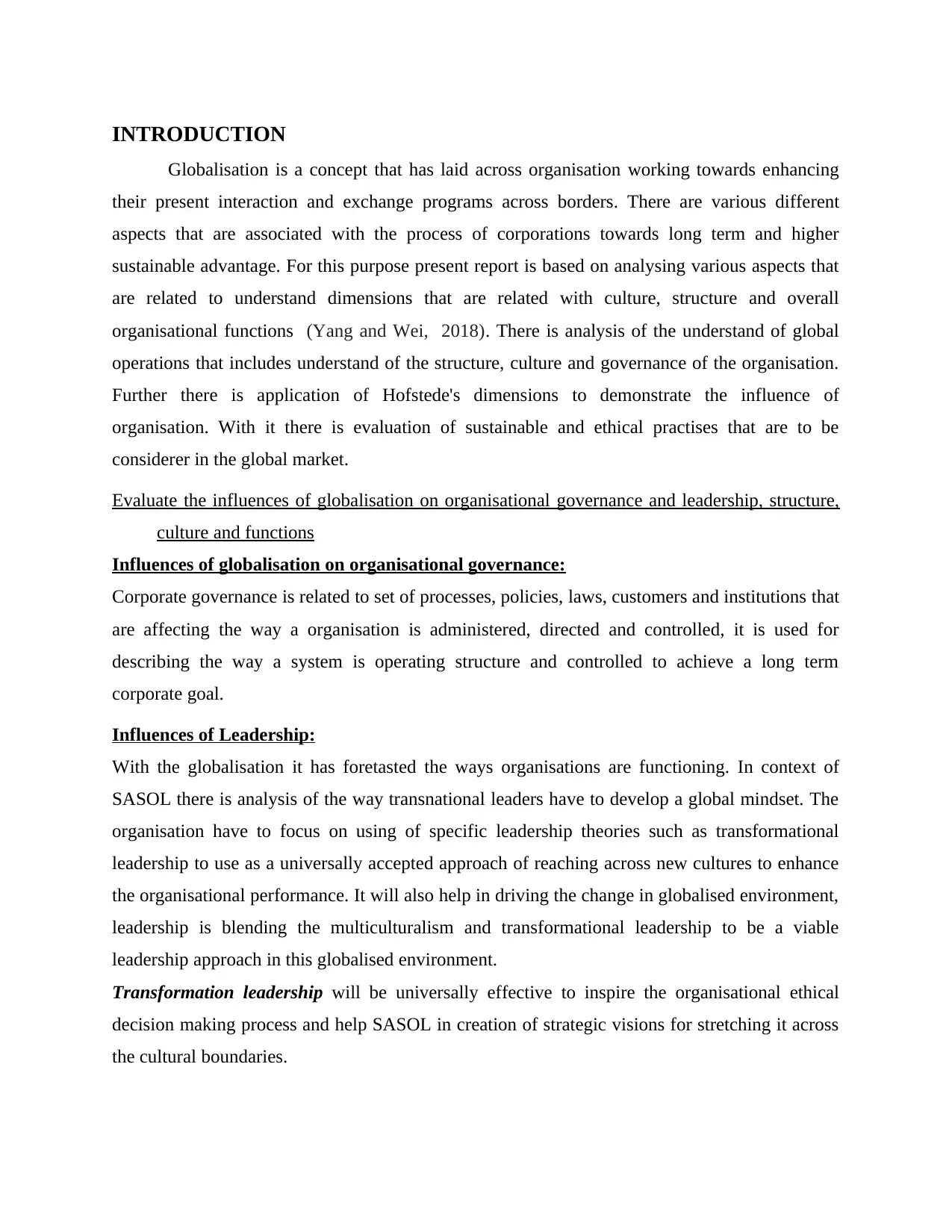
INTRODUCTION
Globalisation is a concept that has laid across organisation working towards enhancing
their present interaction and exchange programs across borders. There are various different
aspects that are associated with the process of corporations towards long term and higher
sustainable advantage. For this purpose present report is based on analysing various aspects that
are related to understand dimensions that are related with culture, structure and overall
organisational functions (Yang and Wei, 2018). There is analysis of the understand of global
operations that includes understand of the structure, culture and governance of the organisation.
Further there is application of Hofstede's dimensions to demonstrate the influence of
organisation. With it there is evaluation of sustainable and ethical practises that are to be
considerer in the global market.
Evaluate the influences of globalisation on organisational governance and leadership, structure,
culture and functions
Influences of globalisation on organisational governance:
Corporate governance is related to set of processes, policies, laws, customers and institutions that
are affecting the way a organisation is administered, directed and controlled, it is used for
describing the way a system is operating structure and controlled to achieve a long term
corporate goal.
Influences of Leadership:
With the globalisation it has foretasted the ways organisations are functioning. In context of
SASOL there is analysis of the way transnational leaders have to develop a global mindset. The
organisation have to focus on using of specific leadership theories such as transformational
leadership to use as a universally accepted approach of reaching across new cultures to enhance
the organisational performance. It will also help in driving the change in globalised environment,
leadership is blending the multiculturalism and transformational leadership to be a viable
leadership approach in this globalised environment.
Transformation leadership will be universally effective to inspire the organisational ethical
decision making process and help SASOL in creation of strategic visions for stretching it across
the cultural boundaries.
Globalisation is a concept that has laid across organisation working towards enhancing
their present interaction and exchange programs across borders. There are various different
aspects that are associated with the process of corporations towards long term and higher
sustainable advantage. For this purpose present report is based on analysing various aspects that
are related to understand dimensions that are related with culture, structure and overall
organisational functions (Yang and Wei, 2018). There is analysis of the understand of global
operations that includes understand of the structure, culture and governance of the organisation.
Further there is application of Hofstede's dimensions to demonstrate the influence of
organisation. With it there is evaluation of sustainable and ethical practises that are to be
considerer in the global market.
Evaluate the influences of globalisation on organisational governance and leadership, structure,
culture and functions
Influences of globalisation on organisational governance:
Corporate governance is related to set of processes, policies, laws, customers and institutions that
are affecting the way a organisation is administered, directed and controlled, it is used for
describing the way a system is operating structure and controlled to achieve a long term
corporate goal.
Influences of Leadership:
With the globalisation it has foretasted the ways organisations are functioning. In context of
SASOL there is analysis of the way transnational leaders have to develop a global mindset. The
organisation have to focus on using of specific leadership theories such as transformational
leadership to use as a universally accepted approach of reaching across new cultures to enhance
the organisational performance. It will also help in driving the change in globalised environment,
leadership is blending the multiculturalism and transformational leadership to be a viable
leadership approach in this globalised environment.
Transformation leadership will be universally effective to inspire the organisational ethical
decision making process and help SASOL in creation of strategic visions for stretching it across
the cultural boundaries.
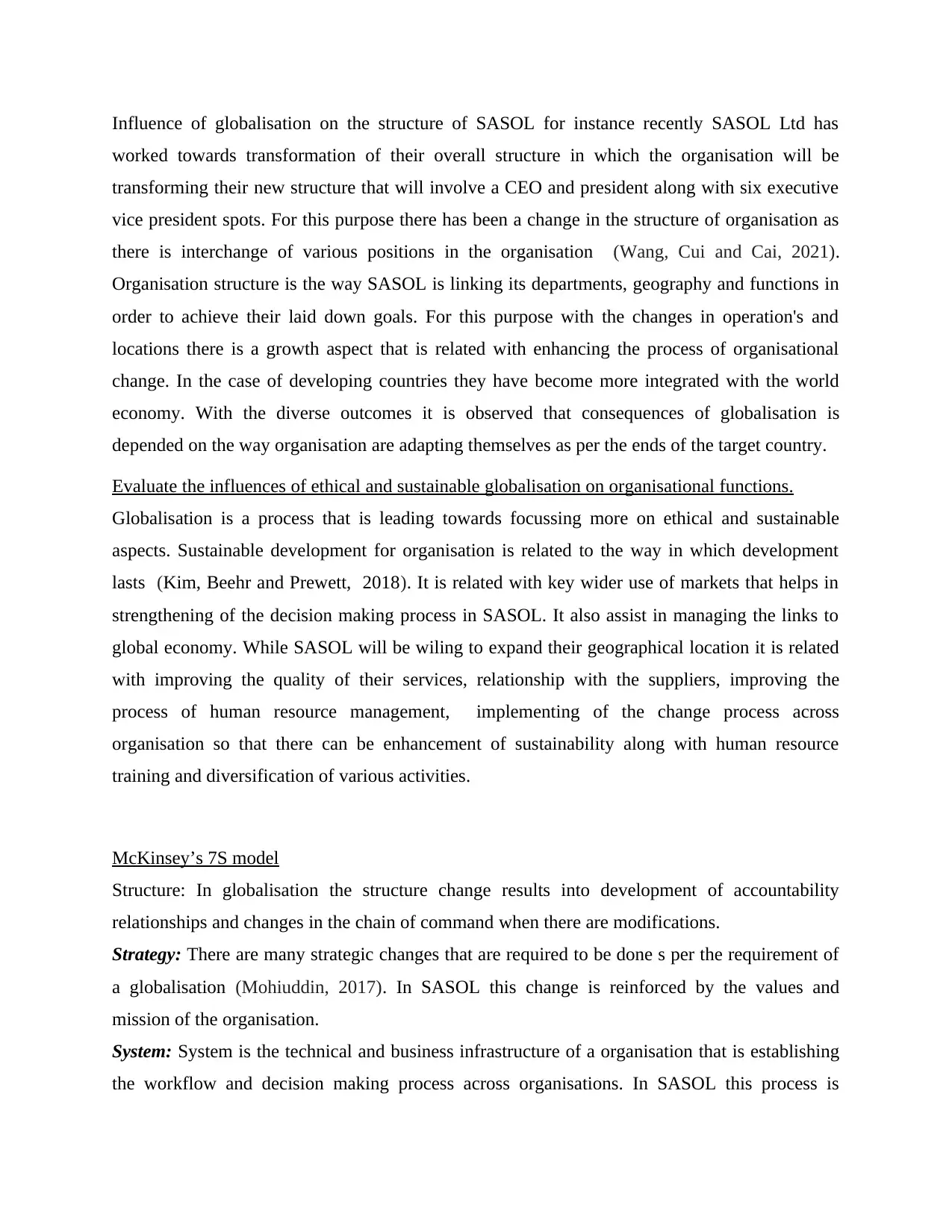
Influence of globalisation on the structure of SASOL for instance recently SASOL Ltd has
worked towards transformation of their overall structure in which the organisation will be
transforming their new structure that will involve a CEO and president along with six executive
vice president spots. For this purpose there has been a change in the structure of organisation as
there is interchange of various positions in the organisation (Wang, Cui and Cai, 2021).
Organisation structure is the way SASOL is linking its departments, geography and functions in
order to achieve their laid down goals. For this purpose with the changes in operation's and
locations there is a growth aspect that is related with enhancing the process of organisational
change. In the case of developing countries they have become more integrated with the world
economy. With the diverse outcomes it is observed that consequences of globalisation is
depended on the way organisation are adapting themselves as per the ends of the target country.
Evaluate the influences of ethical and sustainable globalisation on organisational functions.
Globalisation is a process that is leading towards focussing more on ethical and sustainable
aspects. Sustainable development for organisation is related to the way in which development
lasts (Kim, Beehr and Prewett, 2018). It is related with key wider use of markets that helps in
strengthening of the decision making process in SASOL. It also assist in managing the links to
global economy. While SASOL will be wiling to expand their geographical location it is related
with improving the quality of their services, relationship with the suppliers, improving the
process of human resource management, implementing of the change process across
organisation so that there can be enhancement of sustainability along with human resource
training and diversification of various activities.
McKinsey’s 7S model
Structure: In globalisation the structure change results into development of accountability
relationships and changes in the chain of command when there are modifications.
Strategy: There are many strategic changes that are required to be done s per the requirement of
a globalisation (Mohiuddin, 2017). In SASOL this change is reinforced by the values and
mission of the organisation.
System: System is the technical and business infrastructure of a organisation that is establishing
the workflow and decision making process across organisations. In SASOL this process is
worked towards transformation of their overall structure in which the organisation will be
transforming their new structure that will involve a CEO and president along with six executive
vice president spots. For this purpose there has been a change in the structure of organisation as
there is interchange of various positions in the organisation (Wang, Cui and Cai, 2021).
Organisation structure is the way SASOL is linking its departments, geography and functions in
order to achieve their laid down goals. For this purpose with the changes in operation's and
locations there is a growth aspect that is related with enhancing the process of organisational
change. In the case of developing countries they have become more integrated with the world
economy. With the diverse outcomes it is observed that consequences of globalisation is
depended on the way organisation are adapting themselves as per the ends of the target country.
Evaluate the influences of ethical and sustainable globalisation on organisational functions.
Globalisation is a process that is leading towards focussing more on ethical and sustainable
aspects. Sustainable development for organisation is related to the way in which development
lasts (Kim, Beehr and Prewett, 2018). It is related with key wider use of markets that helps in
strengthening of the decision making process in SASOL. It also assist in managing the links to
global economy. While SASOL will be wiling to expand their geographical location it is related
with improving the quality of their services, relationship with the suppliers, improving the
process of human resource management, implementing of the change process across
organisation so that there can be enhancement of sustainability along with human resource
training and diversification of various activities.
McKinsey’s 7S model
Structure: In globalisation the structure change results into development of accountability
relationships and changes in the chain of command when there are modifications.
Strategy: There are many strategic changes that are required to be done s per the requirement of
a globalisation (Mohiuddin, 2017). In SASOL this change is reinforced by the values and
mission of the organisation.
System: System is the technical and business infrastructure of a organisation that is establishing
the workflow and decision making process across organisations. In SASOL this process is
Secure Best Marks with AI Grader
Need help grading? Try our AI Grader for instant feedback on your assignments.
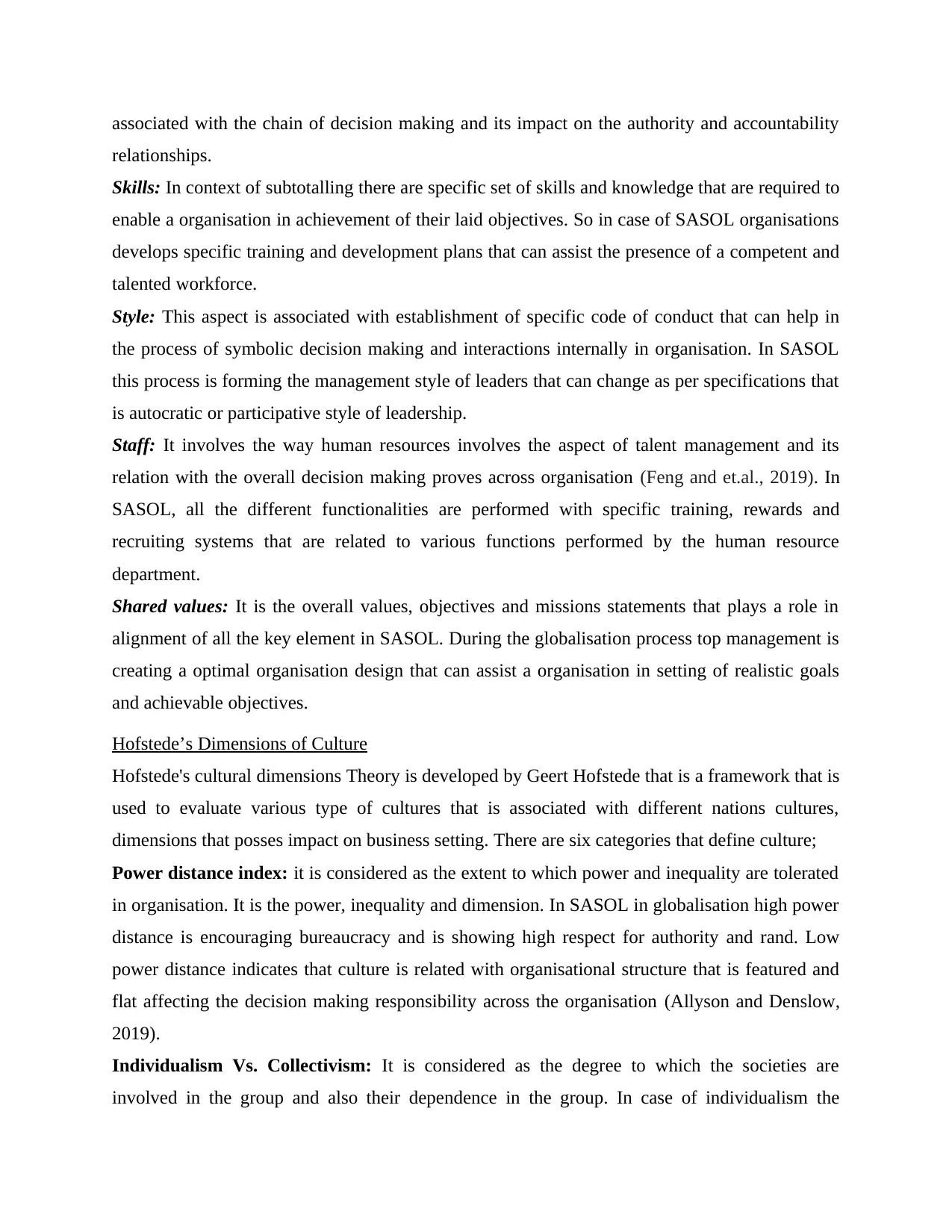
associated with the chain of decision making and its impact on the authority and accountability
relationships.
Skills: In context of subtotalling there are specific set of skills and knowledge that are required to
enable a organisation in achievement of their laid objectives. So in case of SASOL organisations
develops specific training and development plans that can assist the presence of a competent and
talented workforce.
Style: This aspect is associated with establishment of specific code of conduct that can help in
the process of symbolic decision making and interactions internally in organisation. In SASOL
this process is forming the management style of leaders that can change as per specifications that
is autocratic or participative style of leadership.
Staff: It involves the way human resources involves the aspect of talent management and its
relation with the overall decision making proves across organisation (Feng and et.al., 2019). In
SASOL, all the different functionalities are performed with specific training, rewards and
recruiting systems that are related to various functions performed by the human resource
department.
Shared values: It is the overall values, objectives and missions statements that plays a role in
alignment of all the key element in SASOL. During the globalisation process top management is
creating a optimal organisation design that can assist a organisation in setting of realistic goals
and achievable objectives.
Hofstede’s Dimensions of Culture
Hofstede's cultural dimensions Theory is developed by Geert Hofstede that is a framework that is
used to evaluate various type of cultures that is associated with different nations cultures,
dimensions that posses impact on business setting. There are six categories that define culture;
Power distance index: it is considered as the extent to which power and inequality are tolerated
in organisation. It is the power, inequality and dimension. In SASOL in globalisation high power
distance is encouraging bureaucracy and is showing high respect for authority and rand. Low
power distance indicates that culture is related with organisational structure that is featured and
flat affecting the decision making responsibility across the organisation (Allyson and Denslow,
2019).
Individualism Vs. Collectivism: It is considered as the degree to which the societies are
involved in the group and also their dependence in the group. In case of individualism the
relationships.
Skills: In context of subtotalling there are specific set of skills and knowledge that are required to
enable a organisation in achievement of their laid objectives. So in case of SASOL organisations
develops specific training and development plans that can assist the presence of a competent and
talented workforce.
Style: This aspect is associated with establishment of specific code of conduct that can help in
the process of symbolic decision making and interactions internally in organisation. In SASOL
this process is forming the management style of leaders that can change as per specifications that
is autocratic or participative style of leadership.
Staff: It involves the way human resources involves the aspect of talent management and its
relation with the overall decision making proves across organisation (Feng and et.al., 2019). In
SASOL, all the different functionalities are performed with specific training, rewards and
recruiting systems that are related to various functions performed by the human resource
department.
Shared values: It is the overall values, objectives and missions statements that plays a role in
alignment of all the key element in SASOL. During the globalisation process top management is
creating a optimal organisation design that can assist a organisation in setting of realistic goals
and achievable objectives.
Hofstede’s Dimensions of Culture
Hofstede's cultural dimensions Theory is developed by Geert Hofstede that is a framework that is
used to evaluate various type of cultures that is associated with different nations cultures,
dimensions that posses impact on business setting. There are six categories that define culture;
Power distance index: it is considered as the extent to which power and inequality are tolerated
in organisation. It is the power, inequality and dimension. In SASOL in globalisation high power
distance is encouraging bureaucracy and is showing high respect for authority and rand. Low
power distance indicates that culture is related with organisational structure that is featured and
flat affecting the decision making responsibility across the organisation (Allyson and Denslow,
2019).
Individualism Vs. Collectivism: It is considered as the degree to which the societies are
involved in the group and also their dependence in the group. In case of individualism the
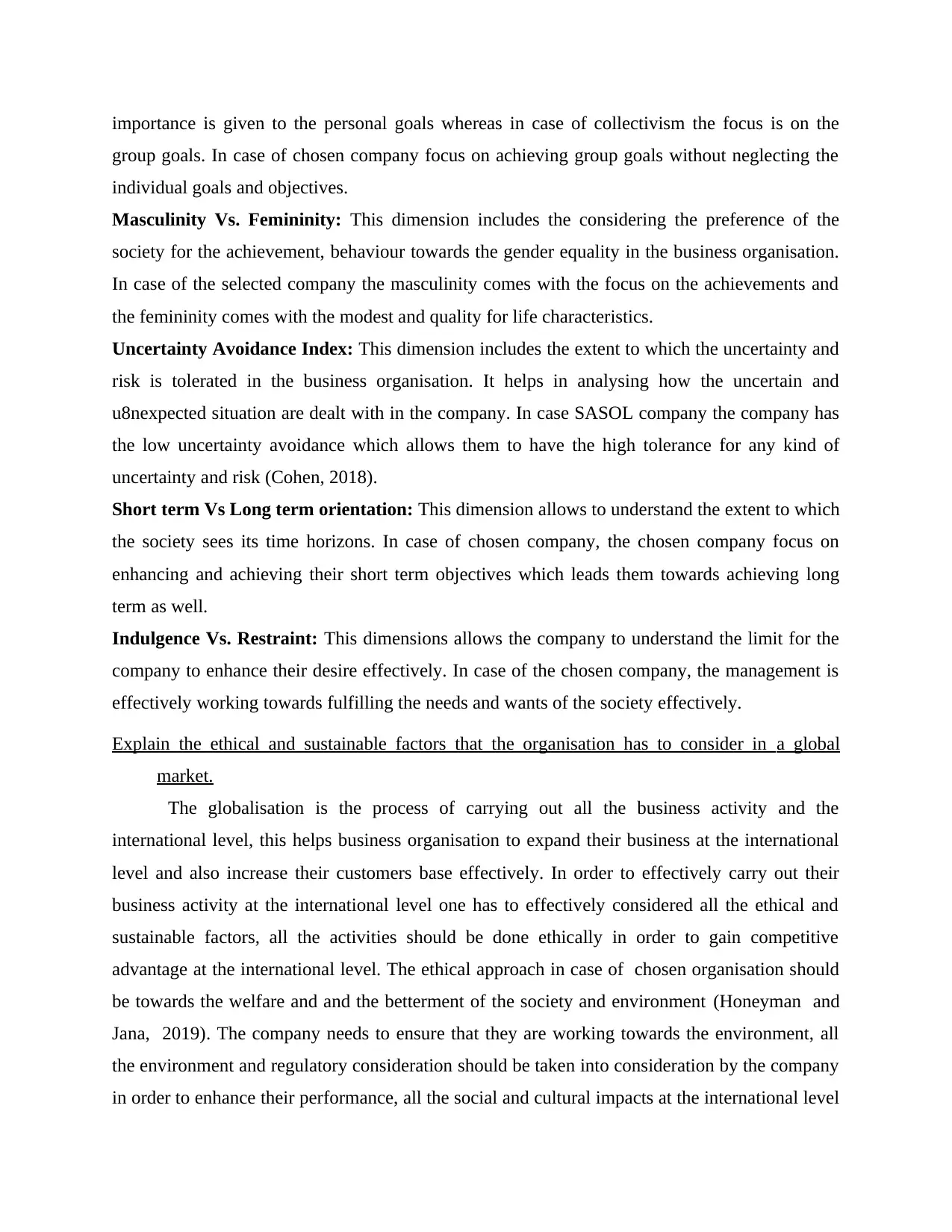
importance is given to the personal goals whereas in case of collectivism the focus is on the
group goals. In case of chosen company focus on achieving group goals without neglecting the
individual goals and objectives.
Masculinity Vs. Femininity: This dimension includes the considering the preference of the
society for the achievement, behaviour towards the gender equality in the business organisation.
In case of the selected company the masculinity comes with the focus on the achievements and
the femininity comes with the modest and quality for life characteristics.
Uncertainty Avoidance Index: This dimension includes the extent to which the uncertainty and
risk is tolerated in the business organisation. It helps in analysing how the uncertain and
u8nexpected situation are dealt with in the company. In case SASOL company the company has
the low uncertainty avoidance which allows them to have the high tolerance for any kind of
uncertainty and risk (Cohen, 2018).
Short term Vs Long term orientation: This dimension allows to understand the extent to which
the society sees its time horizons. In case of chosen company, the chosen company focus on
enhancing and achieving their short term objectives which leads them towards achieving long
term as well.
Indulgence Vs. Restraint: This dimensions allows the company to understand the limit for the
company to enhance their desire effectively. In case of the chosen company, the management is
effectively working towards fulfilling the needs and wants of the society effectively.
Explain the ethical and sustainable factors that the organisation has to consider in a global
market.
The globalisation is the process of carrying out all the business activity and the
international level, this helps business organisation to expand their business at the international
level and also increase their customers base effectively. In order to effectively carry out their
business activity at the international level one has to effectively considered all the ethical and
sustainable factors, all the activities should be done ethically in order to gain competitive
advantage at the international level. The ethical approach in case of chosen organisation should
be towards the welfare and and the betterment of the society and environment (Honeyman and
Jana, 2019). The company needs to ensure that they are working towards the environment, all
the environment and regulatory consideration should be taken into consideration by the company
in order to enhance their performance, all the social and cultural impacts at the international level
group goals. In case of chosen company focus on achieving group goals without neglecting the
individual goals and objectives.
Masculinity Vs. Femininity: This dimension includes the considering the preference of the
society for the achievement, behaviour towards the gender equality in the business organisation.
In case of the selected company the masculinity comes with the focus on the achievements and
the femininity comes with the modest and quality for life characteristics.
Uncertainty Avoidance Index: This dimension includes the extent to which the uncertainty and
risk is tolerated in the business organisation. It helps in analysing how the uncertain and
u8nexpected situation are dealt with in the company. In case SASOL company the company has
the low uncertainty avoidance which allows them to have the high tolerance for any kind of
uncertainty and risk (Cohen, 2018).
Short term Vs Long term orientation: This dimension allows to understand the extent to which
the society sees its time horizons. In case of chosen company, the chosen company focus on
enhancing and achieving their short term objectives which leads them towards achieving long
term as well.
Indulgence Vs. Restraint: This dimensions allows the company to understand the limit for the
company to enhance their desire effectively. In case of the chosen company, the management is
effectively working towards fulfilling the needs and wants of the society effectively.
Explain the ethical and sustainable factors that the organisation has to consider in a global
market.
The globalisation is the process of carrying out all the business activity and the
international level, this helps business organisation to expand their business at the international
level and also increase their customers base effectively. In order to effectively carry out their
business activity at the international level one has to effectively considered all the ethical and
sustainable factors, all the activities should be done ethically in order to gain competitive
advantage at the international level. The ethical approach in case of chosen organisation should
be towards the welfare and and the betterment of the society and environment (Honeyman and
Jana, 2019). The company needs to ensure that they are working towards the environment, all
the environment and regulatory consideration should be taken into consideration by the company
in order to enhance their performance, all the social and cultural impacts at the international level
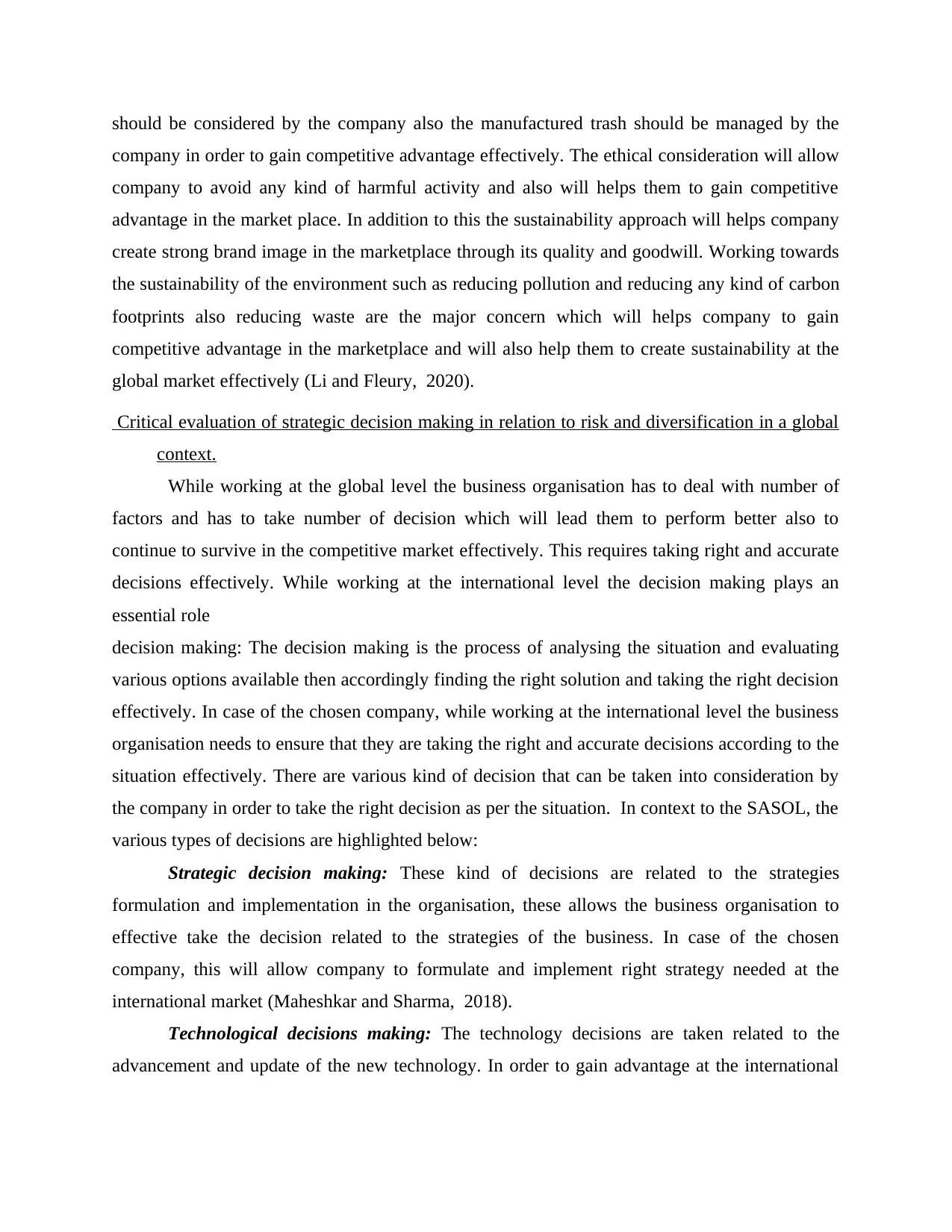
should be considered by the company also the manufactured trash should be managed by the
company in order to gain competitive advantage effectively. The ethical consideration will allow
company to avoid any kind of harmful activity and also will helps them to gain competitive
advantage in the market place. In addition to this the sustainability approach will helps company
create strong brand image in the marketplace through its quality and goodwill. Working towards
the sustainability of the environment such as reducing pollution and reducing any kind of carbon
footprints also reducing waste are the major concern which will helps company to gain
competitive advantage in the marketplace and will also help them to create sustainability at the
global market effectively (Li and Fleury, 2020).
Critical evaluation of strategic decision making in relation to risk and diversification in a global
context.
While working at the global level the business organisation has to deal with number of
factors and has to take number of decision which will lead them to perform better also to
continue to survive in the competitive market effectively. This requires taking right and accurate
decisions effectively. While working at the international level the decision making plays an
essential role
decision making: The decision making is the process of analysing the situation and evaluating
various options available then accordingly finding the right solution and taking the right decision
effectively. In case of the chosen company, while working at the international level the business
organisation needs to ensure that they are taking the right and accurate decisions according to the
situation effectively. There are various kind of decision that can be taken into consideration by
the company in order to take the right decision as per the situation. In context to the SASOL, the
various types of decisions are highlighted below:
Strategic decision making: These kind of decisions are related to the strategies
formulation and implementation in the organisation, these allows the business organisation to
effective take the decision related to the strategies of the business. In case of the chosen
company, this will allow company to formulate and implement right strategy needed at the
international market (Maheshkar and Sharma, 2018).
Technological decisions making: The technology decisions are taken related to the
advancement and update of the new technology. In order to gain advantage at the international
company in order to gain competitive advantage effectively. The ethical consideration will allow
company to avoid any kind of harmful activity and also will helps them to gain competitive
advantage in the market place. In addition to this the sustainability approach will helps company
create strong brand image in the marketplace through its quality and goodwill. Working towards
the sustainability of the environment such as reducing pollution and reducing any kind of carbon
footprints also reducing waste are the major concern which will helps company to gain
competitive advantage in the marketplace and will also help them to create sustainability at the
global market effectively (Li and Fleury, 2020).
Critical evaluation of strategic decision making in relation to risk and diversification in a global
context.
While working at the global level the business organisation has to deal with number of
factors and has to take number of decision which will lead them to perform better also to
continue to survive in the competitive market effectively. This requires taking right and accurate
decisions effectively. While working at the international level the decision making plays an
essential role
decision making: The decision making is the process of analysing the situation and evaluating
various options available then accordingly finding the right solution and taking the right decision
effectively. In case of the chosen company, while working at the international level the business
organisation needs to ensure that they are taking the right and accurate decisions according to the
situation effectively. There are various kind of decision that can be taken into consideration by
the company in order to take the right decision as per the situation. In context to the SASOL, the
various types of decisions are highlighted below:
Strategic decision making: These kind of decisions are related to the strategies
formulation and implementation in the organisation, these allows the business organisation to
effective take the decision related to the strategies of the business. In case of the chosen
company, this will allow company to formulate and implement right strategy needed at the
international market (Maheshkar and Sharma, 2018).
Technological decisions making: The technology decisions are taken related to the
advancement and update of the new technology. In order to gain advantage at the international
Paraphrase This Document
Need a fresh take? Get an instant paraphrase of this document with our AI Paraphraser

level it becomes essential for the chosen company to take the right decision related to the update
of new technology.
Operational decisions: The another decision is related to the operational activity of the
business, effective flow of the operational activity allows the business organisation to enhance
their overall performance. In case of chosen company there are various decisions related to
operations of the business that needs to be taken effectively.
The decision making plays an essential role in the smooth functioning of the business and
also enhancing the overall performance of the business. In case of the SASOL company needs to
ensure that they are effectively taking decision analysing the situation, which will help them to
enhance their overall performance (Mezghani, K. and Aloulou, 2019).
Discuss and critical assess of the range of strategic global expansion routes present to the
organisation
With growing globalisation large number of business are moving towards the
international market in order to enhance their market size and also to increase their customers
base effectively. There are various routes to internationalisation that can be considered by the
business organisation. In context to SASOL, the various route to the internationalisation are
mentioned below:
Direct Exporting: The first method is the direct exporting, this method will allow the
business organisation to directly export or sell their product and services to the international
market, it is considered to the fastest mode of entry into the international market for the business
organisation. This will allow the company to directly sell their product and services into the
international market with the involvement of any third party.
Licensing: The another mode of the entry into the international market is through the
licensing, under this the business organisation or the licensor gives the right to the licensee or the
party available in the local market to use the product and services, under this the ownership opf
the product and services remains with the company (Neufeld, 2020).
Franchising: The another one is the franchising, it is basically the agreement between
the franchiser and the franchisee, where the right to use the intellectual property is given to the
franchisee present in the location where you want to start your own business. Under this the
franchisee enjoys the ownership of the company in the other location effectively.
of new technology.
Operational decisions: The another decision is related to the operational activity of the
business, effective flow of the operational activity allows the business organisation to enhance
their overall performance. In case of chosen company there are various decisions related to
operations of the business that needs to be taken effectively.
The decision making plays an essential role in the smooth functioning of the business and
also enhancing the overall performance of the business. In case of the SASOL company needs to
ensure that they are effectively taking decision analysing the situation, which will help them to
enhance their overall performance (Mezghani, K. and Aloulou, 2019).
Discuss and critical assess of the range of strategic global expansion routes present to the
organisation
With growing globalisation large number of business are moving towards the
international market in order to enhance their market size and also to increase their customers
base effectively. There are various routes to internationalisation that can be considered by the
business organisation. In context to SASOL, the various route to the internationalisation are
mentioned below:
Direct Exporting: The first method is the direct exporting, this method will allow the
business organisation to directly export or sell their product and services to the international
market, it is considered to the fastest mode of entry into the international market for the business
organisation. This will allow the company to directly sell their product and services into the
international market with the involvement of any third party.
Licensing: The another mode of the entry into the international market is through the
licensing, under this the business organisation or the licensor gives the right to the licensee or the
party available in the local market to use the product and services, under this the ownership opf
the product and services remains with the company (Neufeld, 2020).
Franchising: The another one is the franchising, it is basically the agreement between
the franchiser and the franchisee, where the right to use the intellectual property is given to the
franchisee present in the location where you want to start your own business. Under this the
franchisee enjoys the ownership of the company in the other location effectively.
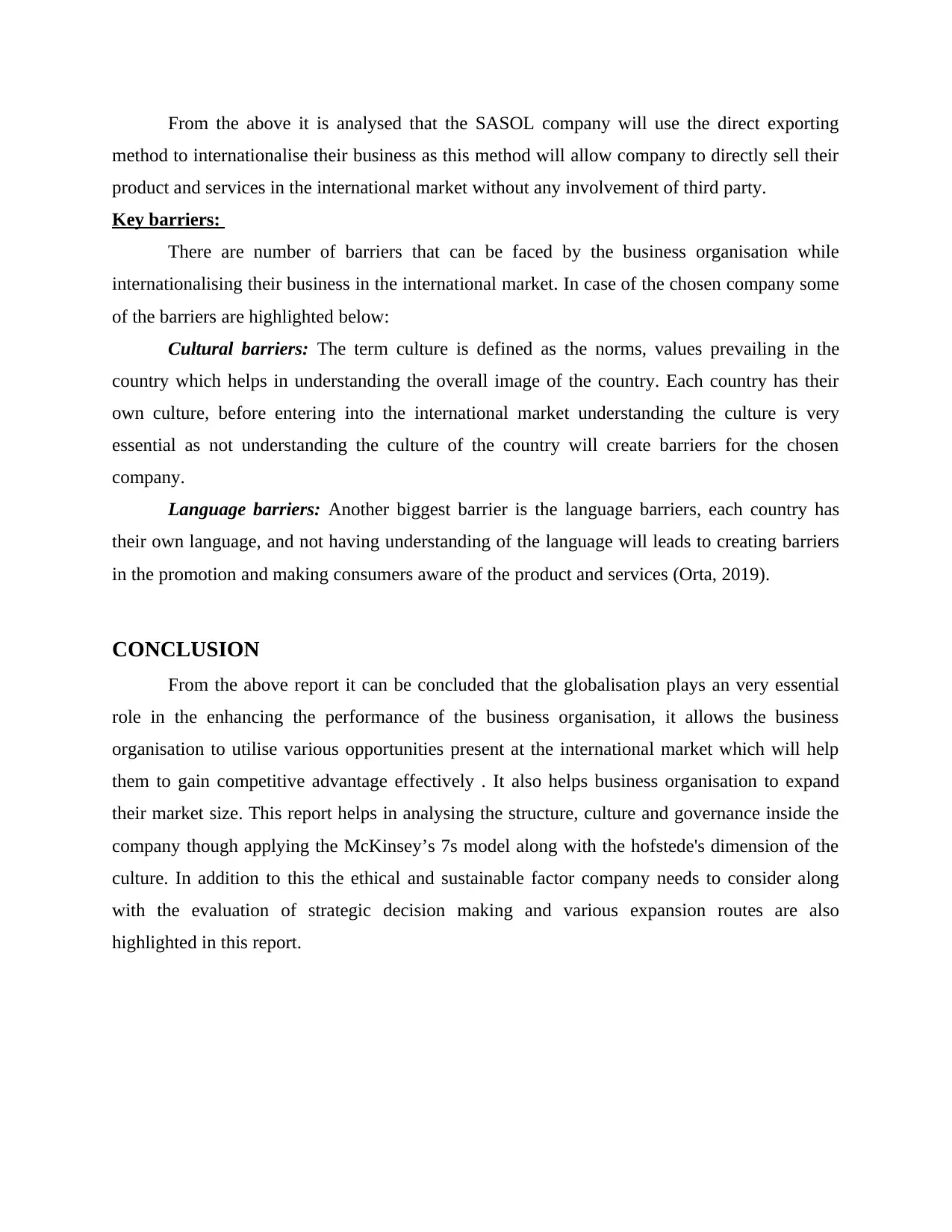
From the above it is analysed that the SASOL company will use the direct exporting
method to internationalise their business as this method will allow company to directly sell their
product and services in the international market without any involvement of third party.
Key barriers:
There are number of barriers that can be faced by the business organisation while
internationalising their business in the international market. In case of the chosen company some
of the barriers are highlighted below:
Cultural barriers: The term culture is defined as the norms, values prevailing in the
country which helps in understanding the overall image of the country. Each country has their
own culture, before entering into the international market understanding the culture is very
essential as not understanding the culture of the country will create barriers for the chosen
company.
Language barriers: Another biggest barrier is the language barriers, each country has
their own language, and not having understanding of the language will leads to creating barriers
in the promotion and making consumers aware of the product and services (Orta, 2019).
CONCLUSION
From the above report it can be concluded that the globalisation plays an very essential
role in the enhancing the performance of the business organisation, it allows the business
organisation to utilise various opportunities present at the international market which will help
them to gain competitive advantage effectively . It also helps business organisation to expand
their market size. This report helps in analysing the structure, culture and governance inside the
company though applying the McKinsey’s 7s model along with the hofstede's dimension of the
culture. In addition to this the ethical and sustainable factor company needs to consider along
with the evaluation of strategic decision making and various expansion routes are also
highlighted in this report.
method to internationalise their business as this method will allow company to directly sell their
product and services in the international market without any involvement of third party.
Key barriers:
There are number of barriers that can be faced by the business organisation while
internationalising their business in the international market. In case of the chosen company some
of the barriers are highlighted below:
Cultural barriers: The term culture is defined as the norms, values prevailing in the
country which helps in understanding the overall image of the country. Each country has their
own culture, before entering into the international market understanding the culture is very
essential as not understanding the culture of the country will create barriers for the chosen
company.
Language barriers: Another biggest barrier is the language barriers, each country has
their own language, and not having understanding of the language will leads to creating barriers
in the promotion and making consumers aware of the product and services (Orta, 2019).
CONCLUSION
From the above report it can be concluded that the globalisation plays an very essential
role in the enhancing the performance of the business organisation, it allows the business
organisation to utilise various opportunities present at the international market which will help
them to gain competitive advantage effectively . It also helps business organisation to expand
their market size. This report helps in analysing the structure, culture and governance inside the
company though applying the McKinsey’s 7s model along with the hofstede's dimension of the
culture. In addition to this the ethical and sustainable factor company needs to consider along
with the evaluation of strategic decision making and various expansion routes are also
highlighted in this report.
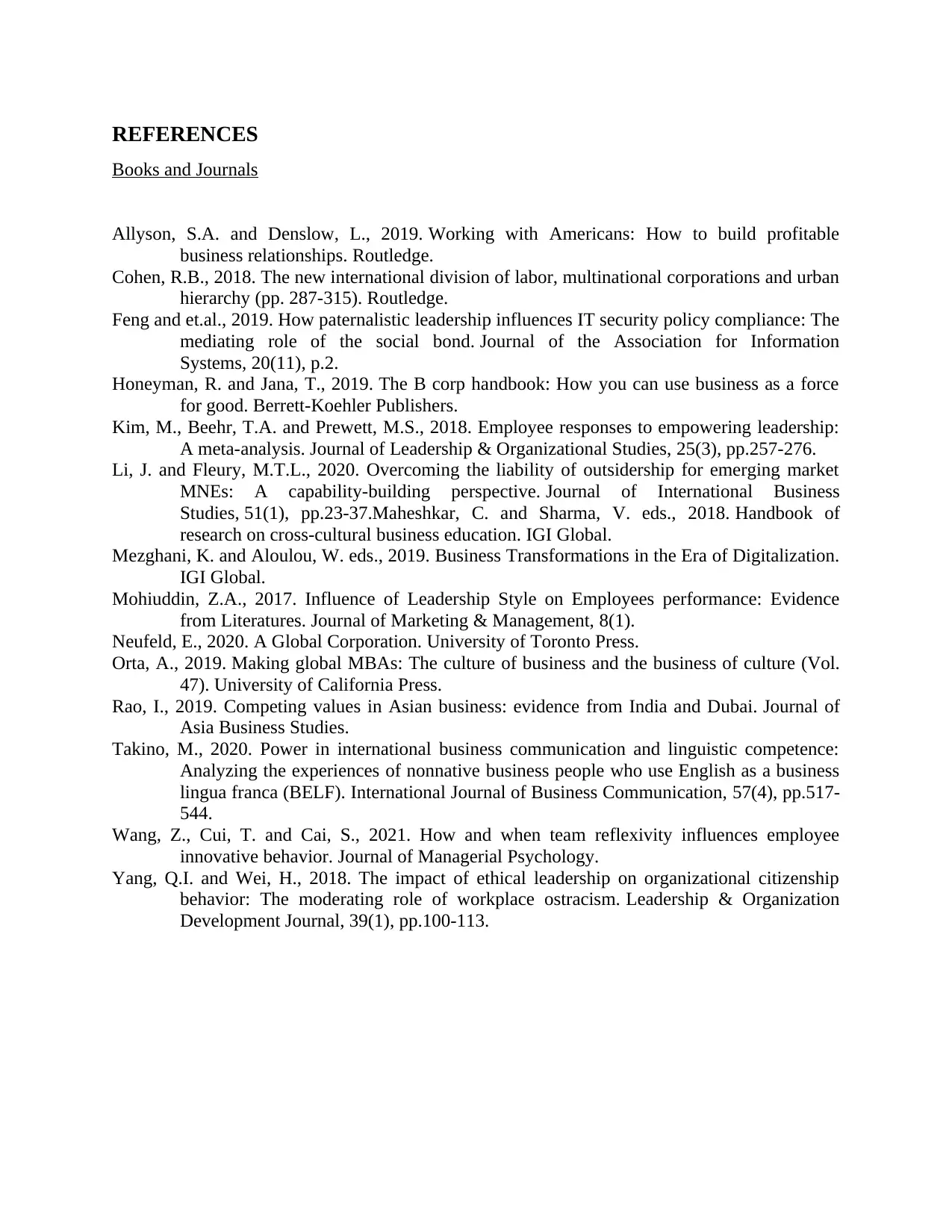
REFERENCES
Books and Journals
Allyson, S.A. and Denslow, L., 2019. Working with Americans: How to build profitable
business relationships. Routledge.
Cohen, R.B., 2018. The new international division of labor, multinational corporations and urban
hierarchy (pp. 287-315). Routledge.
Feng and et.al., 2019. How paternalistic leadership influences IT security policy compliance: The
mediating role of the social bond. Journal of the Association for Information
Systems, 20(11), p.2.
Honeyman, R. and Jana, T., 2019. The B corp handbook: How you can use business as a force
for good. Berrett-Koehler Publishers.
Kim, M., Beehr, T.A. and Prewett, M.S., 2018. Employee responses to empowering leadership:
A meta-analysis. Journal of Leadership & Organizational Studies, 25(3), pp.257-276.
Li, J. and Fleury, M.T.L., 2020. Overcoming the liability of outsidership for emerging market
MNEs: A capability-building perspective. Journal of International Business
Studies, 51(1), pp.23-37.Maheshkar, C. and Sharma, V. eds., 2018. Handbook of
research on cross-cultural business education. IGI Global.
Mezghani, K. and Aloulou, W. eds., 2019. Business Transformations in the Era of Digitalization.
IGI Global.
Mohiuddin, Z.A., 2017. Influence of Leadership Style on Employees performance: Evidence
from Literatures. Journal of Marketing & Management, 8(1).
Neufeld, E., 2020. A Global Corporation. University of Toronto Press.
Orta, A., 2019. Making global MBAs: The culture of business and the business of culture (Vol.
47). University of California Press.
Rao, I., 2019. Competing values in Asian business: evidence from India and Dubai. Journal of
Asia Business Studies.
Takino, M., 2020. Power in international business communication and linguistic competence:
Analyzing the experiences of nonnative business people who use English as a business
lingua franca (BELF). International Journal of Business Communication, 57(4), pp.517-
544.
Wang, Z., Cui, T. and Cai, S., 2021. How and when team reflexivity influences employee
innovative behavior. Journal of Managerial Psychology.
Yang, Q.I. and Wei, H., 2018. The impact of ethical leadership on organizational citizenship
behavior: The moderating role of workplace ostracism. Leadership & Organization
Development Journal, 39(1), pp.100-113.
Books and Journals
Allyson, S.A. and Denslow, L., 2019. Working with Americans: How to build profitable
business relationships. Routledge.
Cohen, R.B., 2018. The new international division of labor, multinational corporations and urban
hierarchy (pp. 287-315). Routledge.
Feng and et.al., 2019. How paternalistic leadership influences IT security policy compliance: The
mediating role of the social bond. Journal of the Association for Information
Systems, 20(11), p.2.
Honeyman, R. and Jana, T., 2019. The B corp handbook: How you can use business as a force
for good. Berrett-Koehler Publishers.
Kim, M., Beehr, T.A. and Prewett, M.S., 2018. Employee responses to empowering leadership:
A meta-analysis. Journal of Leadership & Organizational Studies, 25(3), pp.257-276.
Li, J. and Fleury, M.T.L., 2020. Overcoming the liability of outsidership for emerging market
MNEs: A capability-building perspective. Journal of International Business
Studies, 51(1), pp.23-37.Maheshkar, C. and Sharma, V. eds., 2018. Handbook of
research on cross-cultural business education. IGI Global.
Mezghani, K. and Aloulou, W. eds., 2019. Business Transformations in the Era of Digitalization.
IGI Global.
Mohiuddin, Z.A., 2017. Influence of Leadership Style on Employees performance: Evidence
from Literatures. Journal of Marketing & Management, 8(1).
Neufeld, E., 2020. A Global Corporation. University of Toronto Press.
Orta, A., 2019. Making global MBAs: The culture of business and the business of culture (Vol.
47). University of California Press.
Rao, I., 2019. Competing values in Asian business: evidence from India and Dubai. Journal of
Asia Business Studies.
Takino, M., 2020. Power in international business communication and linguistic competence:
Analyzing the experiences of nonnative business people who use English as a business
lingua franca (BELF). International Journal of Business Communication, 57(4), pp.517-
544.
Wang, Z., Cui, T. and Cai, S., 2021. How and when team reflexivity influences employee
innovative behavior. Journal of Managerial Psychology.
Yang, Q.I. and Wei, H., 2018. The impact of ethical leadership on organizational citizenship
behavior: The moderating role of workplace ostracism. Leadership & Organization
Development Journal, 39(1), pp.100-113.
Secure Best Marks with AI Grader
Need help grading? Try our AI Grader for instant feedback on your assignments.

Appendix:
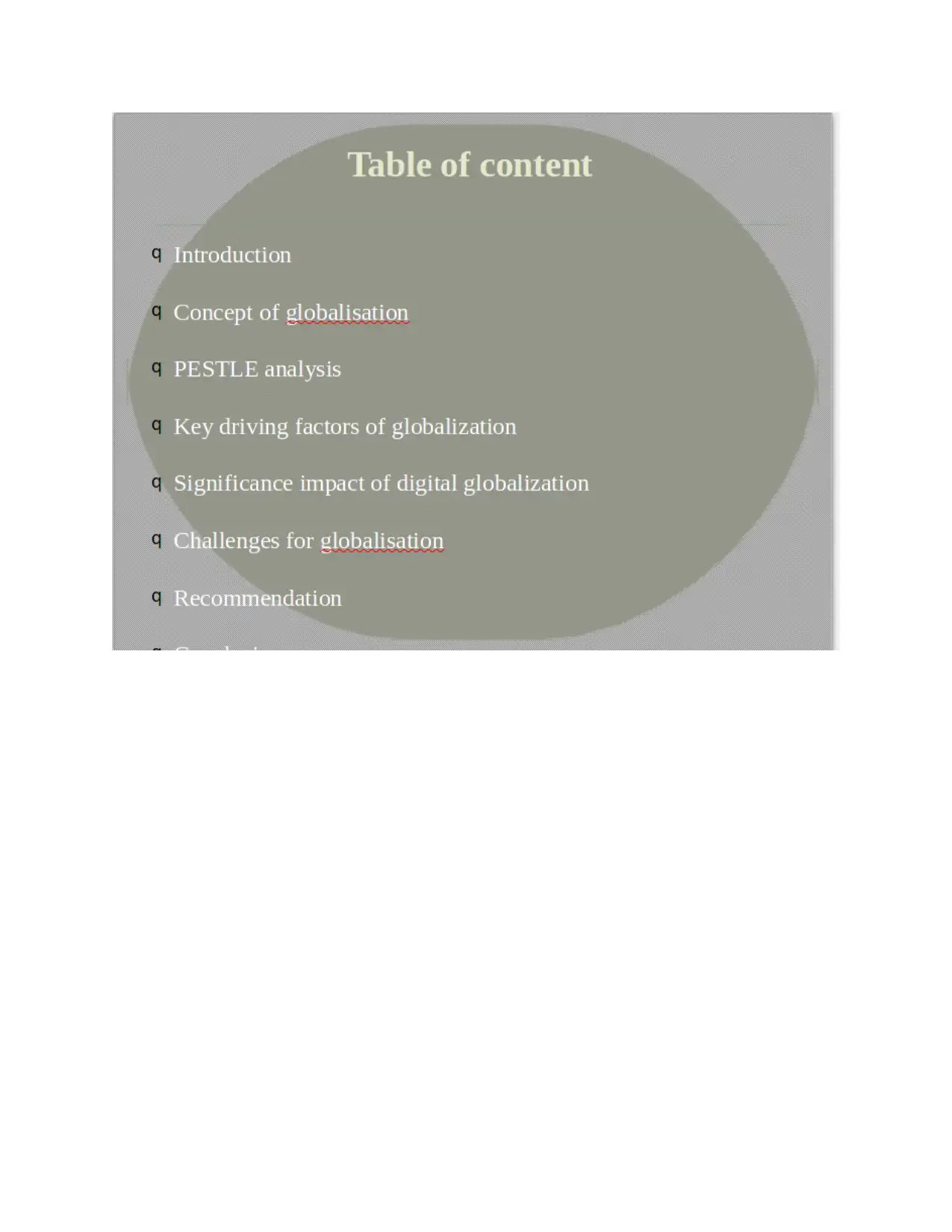
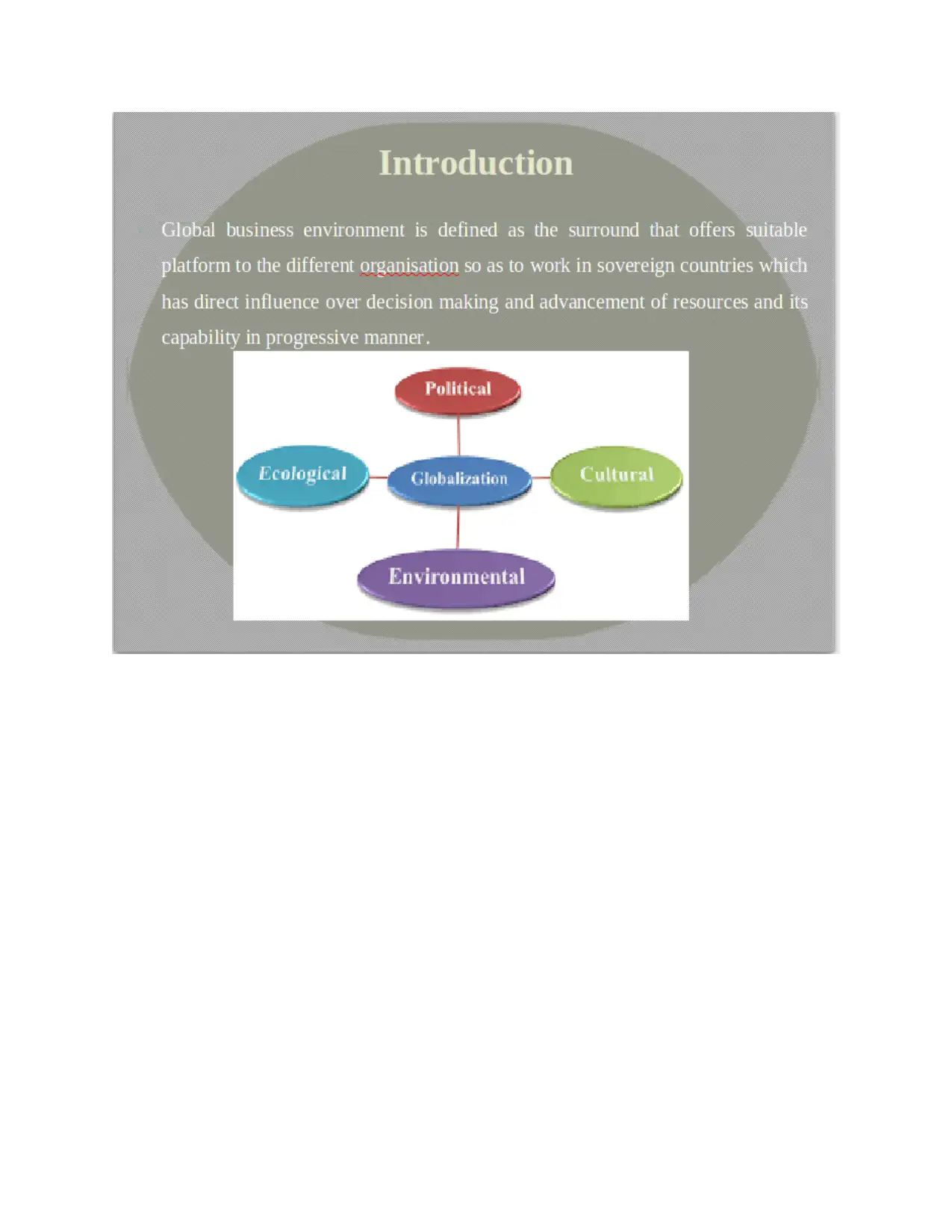
Paraphrase This Document
Need a fresh take? Get an instant paraphrase of this document with our AI Paraphraser



Secure Best Marks with AI Grader
Need help grading? Try our AI Grader for instant feedback on your assignments.
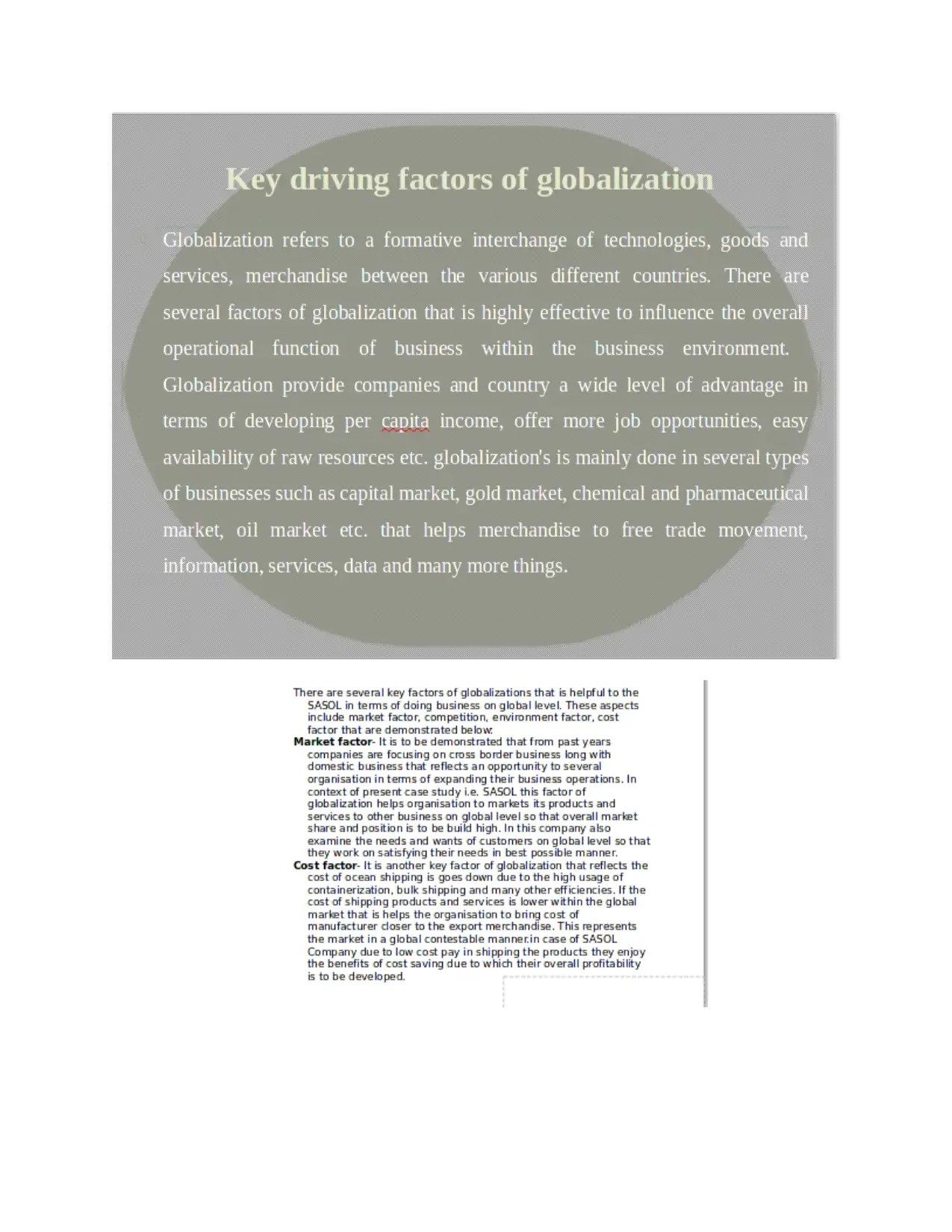
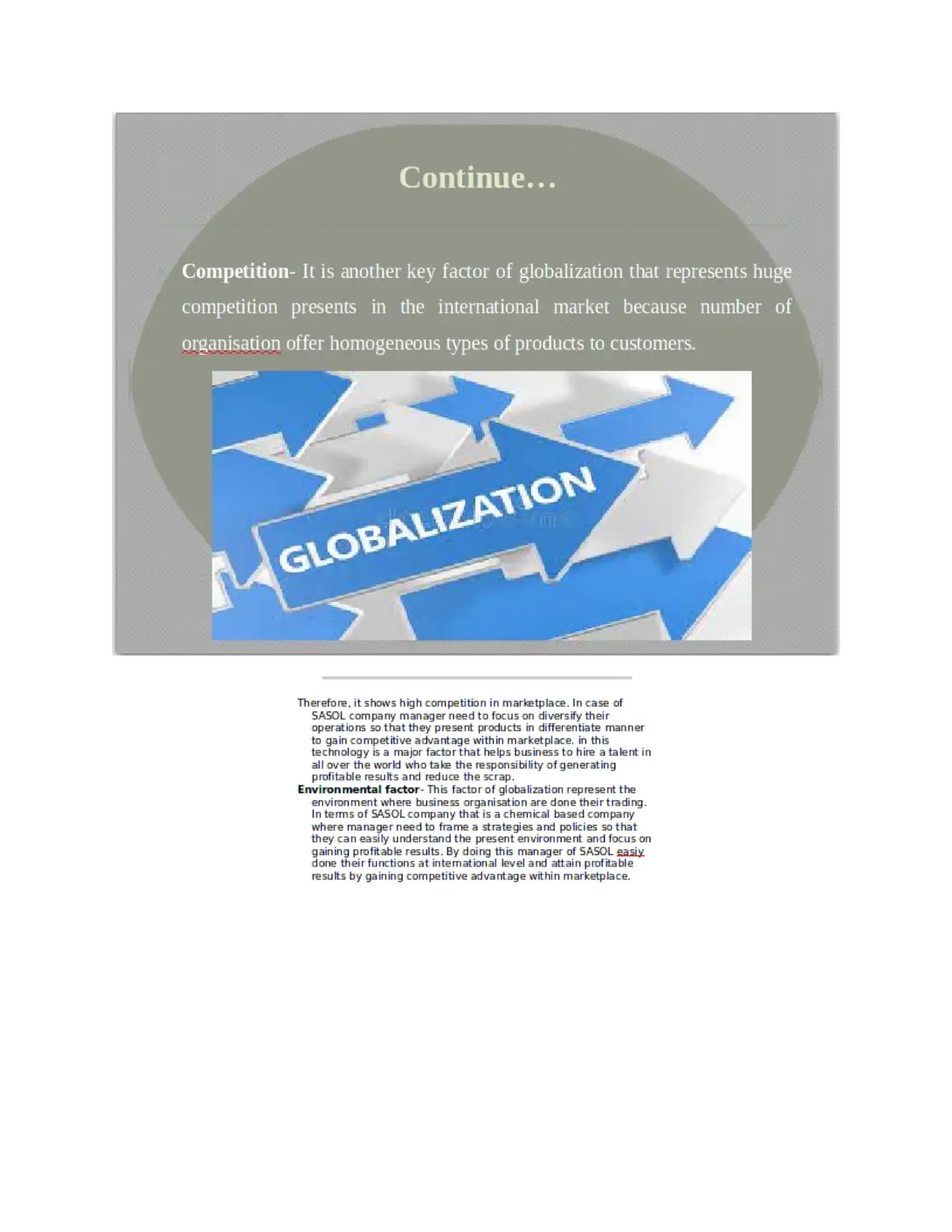
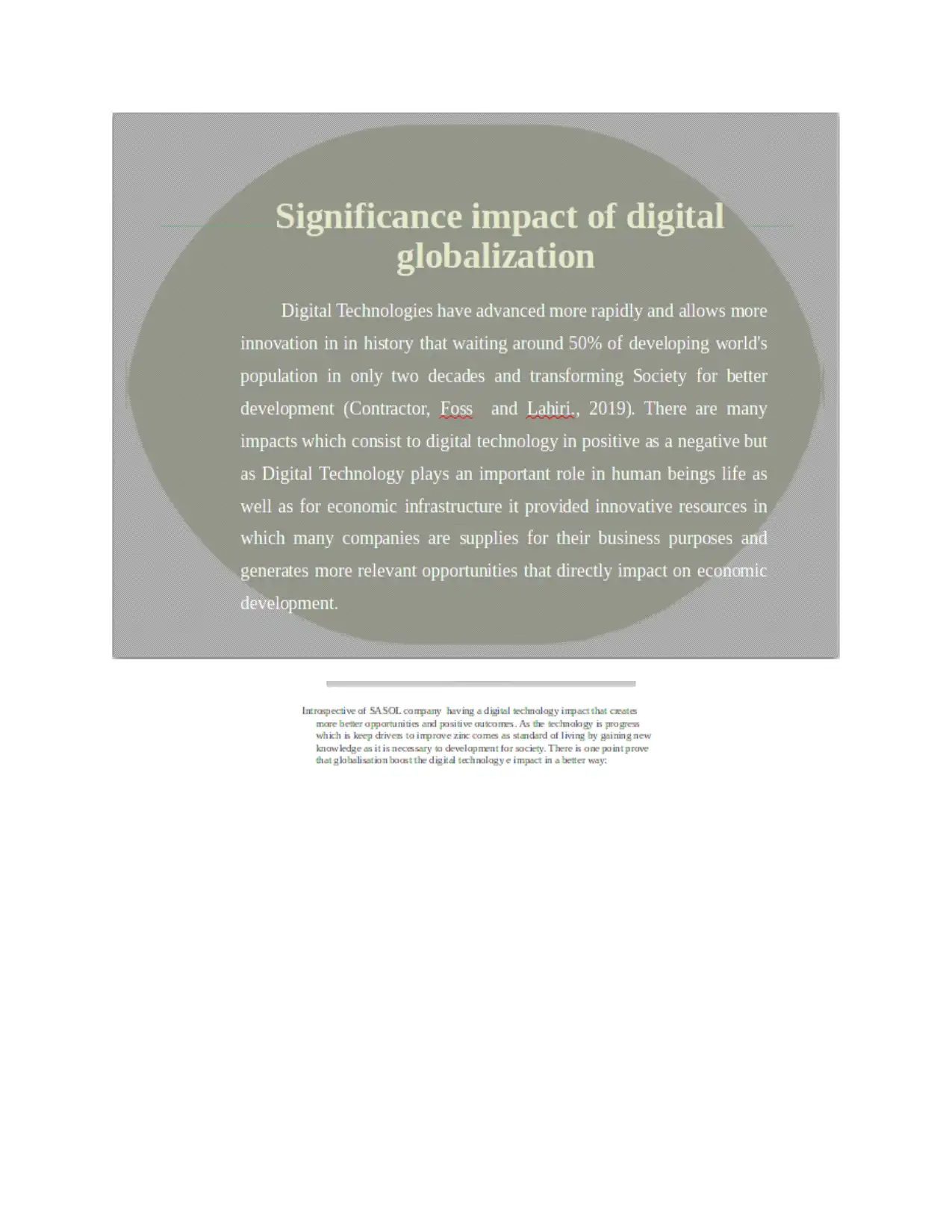
Paraphrase This Document
Need a fresh take? Get an instant paraphrase of this document with our AI Paraphraser


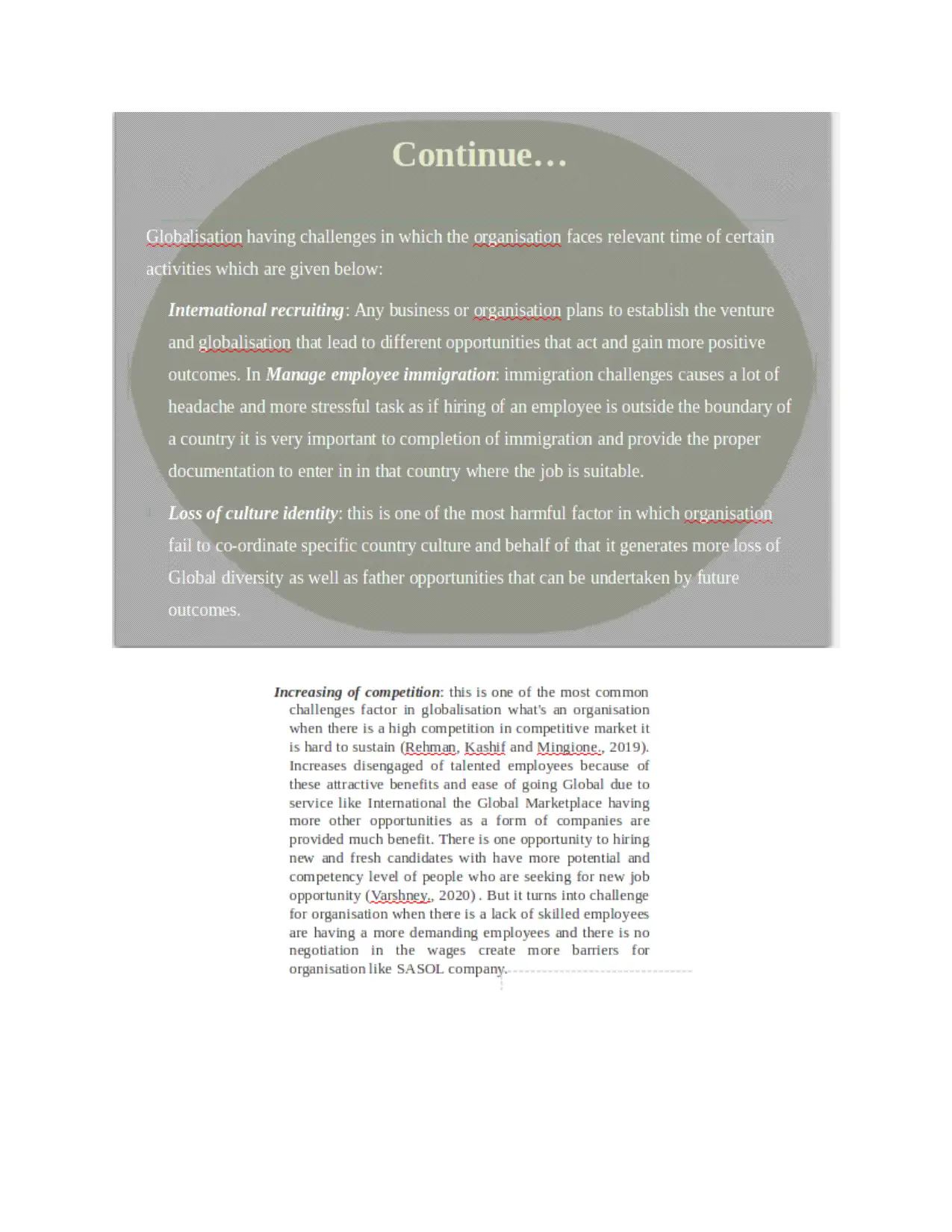
Secure Best Marks with AI Grader
Need help grading? Try our AI Grader for instant feedback on your assignments.
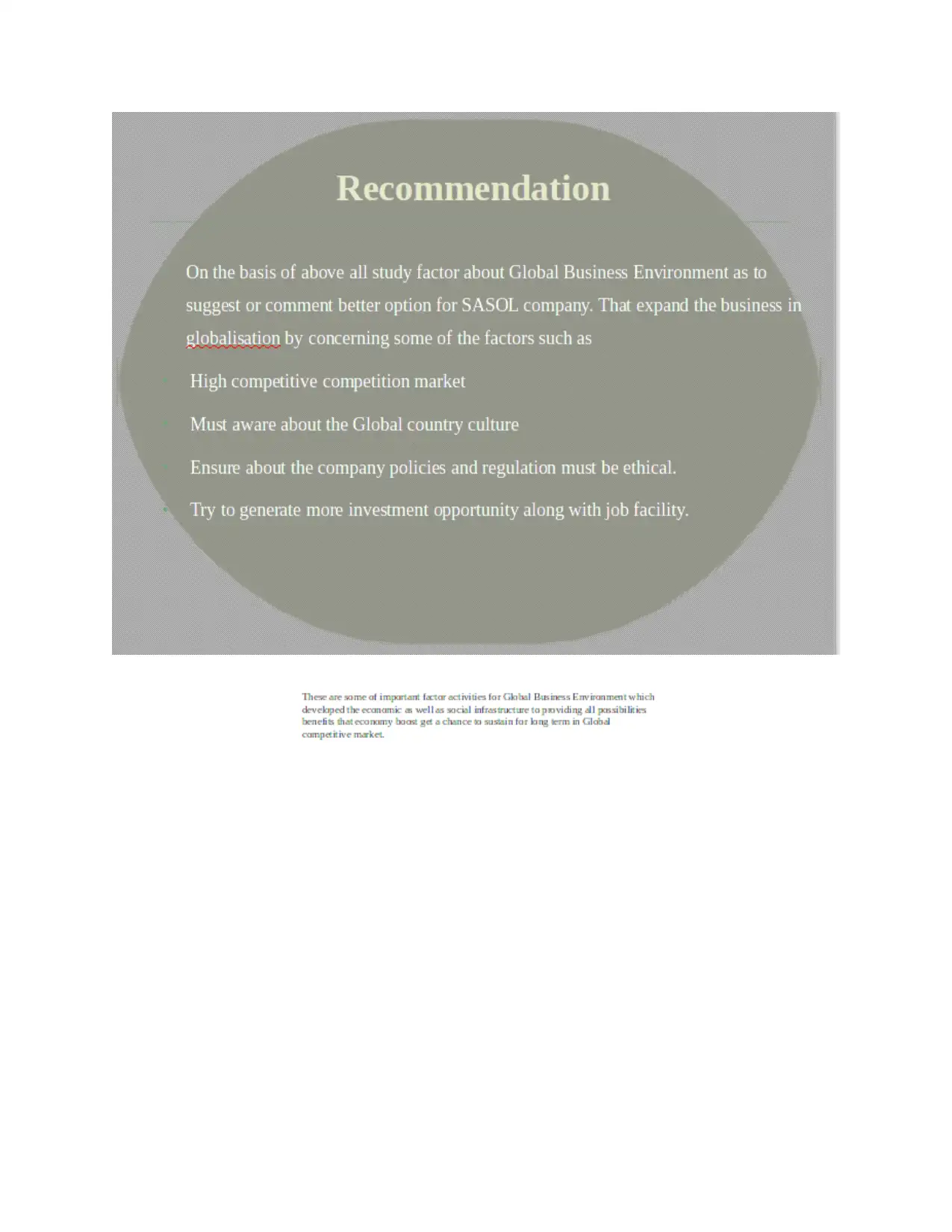


1 out of 25
Related Documents
Your All-in-One AI-Powered Toolkit for Academic Success.
+13062052269
info@desklib.com
Available 24*7 on WhatsApp / Email
![[object Object]](/_next/static/media/star-bottom.7253800d.svg)
Unlock your academic potential
© 2024 | Zucol Services PVT LTD | All rights reserved.


